Upper River
The upper reaches of the Russian River system originate in the rugged, mountainous terrain of the Inner North Coast Ranges, which include the coastal ranges to the west of Hwy 101 and the Mayacmas Mountains lying to the East. Being further from the coast, and experiencing a rainshadow effect, the ranges to the East are dryer and support large areas of chaparral dominated by Chamise (Adenostemma fasciculatum), Manzanita (Arctostaphylos spp.), and Scrub Oak (Quercus spp.).
Patches of serpentine are common and are characterized by conspicuous vegetation and plant communities, including many rare, endemic species that are completely different from those that surround them. Oak woodland and savanna occur at lower elevations on sites with deeper, more fertile soils and support the highest hardwood diversity in the state including common oak species such as Blue Oak (Quercus douglassii), Valley Oak (Q. lobata), Interior Live Oak (Q. wislizeni), as well as California Buckeye (Aesculus californicus), Bay Laurel (Umbellularia californica), and Pacific Madrone (Arbutus menziesii).
Exotic annual grasses and forbs dominate areas of grassland, although, depending on soil moisture availability and disturbance history, some sites contain strands of native perennial bunchgrasses such as California Oat Grass (Danthonia californica), California Fescue (Festuca californica), and Blue Wild Rye (Elymus glaucus).
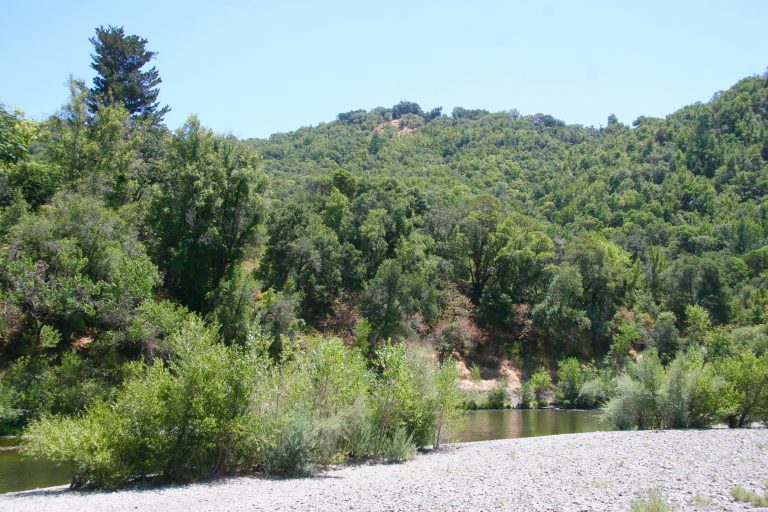
Middle River
The coastal ranges within the Russian River watershed to the West of Hwy 101 are influenced by summer fog, and therefore retain a bit more moisture than the lands to the east. The botanical makeup consists of a mosaic of North coast coniferous, upland broadleaf forest, and oak woodland vegetation types. Forested areas support a diverse mix of native hardwoods and conifers and except where recent clearing has occurred, the vegetation is structurally complex with well-developed tree, shrub and herbaceous layers. Douglas Fir (Pseudotsuga menziesii), Tanoak (Notholithocarpus densiflorus), Black Oak (Quercus kelloggii), and Pacific Madrone (A. menziesii) often dominate north and east-facing sites, whereas mixed hardwood – coniferous forests and woodlands occupy drier locations and include a variety of oak species, California Buckeye (Aesculus californicus), Bay (Umbellularia californica), and Canyon Live Oak (Q. chrysolepis). Common understory shrubs include several species of manzanita (Arctostaphylos spp.), Poison Oak (Toxicodendron diversilobum), and Coyote brush (Bacccharis pilularis). Riparian corridors are often lined with a diverse suite of wetland species including species such as willow (Salix spp.), Fremont cottonwood (Populus fremontii), alder (Alnus spp.), and big leaf maple (Acer macrophyllum).
Lower River to the Pacific
The lowest reaches of the Russian River system are located within the coastal fog belt of the outer North Coast Ranges and experience cool, moist, maritime conditions in contrast to the more continental climate of the inland valleys. A north coast coniferous vegetation type characterizes this region with tree species such as Redwood (Sequoia sempervirens), Douglas Fir (Pseudotsuga menziesii), and Tanoak (Notholithocarpus densiflorus). Patches of upland Coastal Prairie occur on south-facing slopes and ridges, remnants of a once vast and diverse grassland ecosystem that stretched along the northern California Coast.
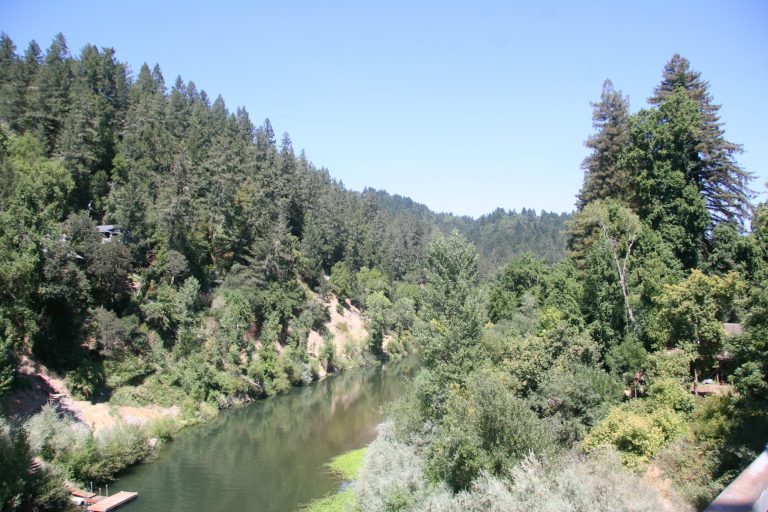
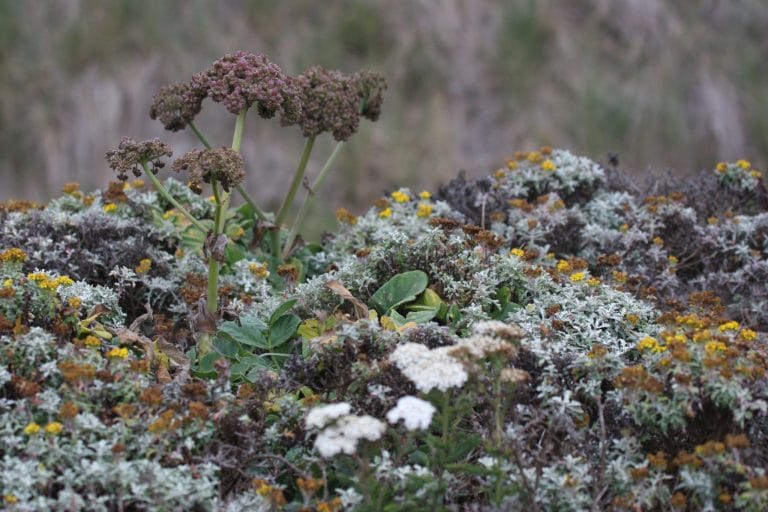
Invasive Plants
Ludwigia
- Excessive growth decreases open water habitat and blocks out light
- Decomposition of plants can lower water quality
- Interferes with recreational activities (beach access, boating, fishing)
- Can decrease flood retention capacity and increase downstream flood impacts
- Ludwigia mats can get in the way of current mosquito control methods
- Careless removal of ludwigia can cause spread downstream
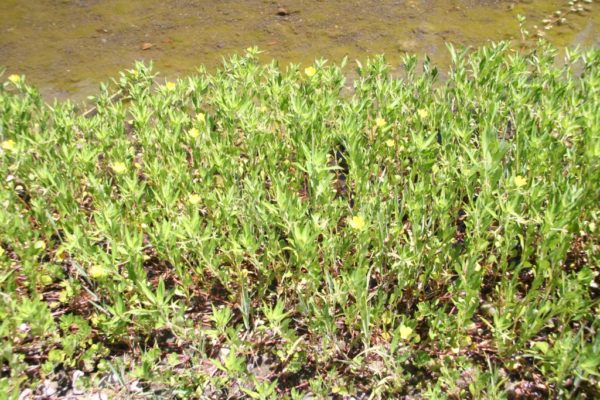
Tips for Removing Ludwigia – Get it before summer starts!
- Manually remove weeds before they flower (April or May). Keep removing resprouts before flowering
(July –August are peak seeding months) - Ensure that all parts of the plant are removed as rapid growth can occur from small pieces of the plant
- Ludwigia may make rich compost but be sure it is composted far away from the river so it cannot
spread - DO NOT let pulled weeds (even small pieces) float downstream! Even small parts of the plant can float downstream and invade another beach. Even if the plants are dead you must remove them because dead plants will decay and deoxygenate the water.
- DO NOT rake weeds into the river
- Floating booms can contain aquatic weeds and enable easier and safer removal
- Rapid response to new invasions is key to control of weed – Get new plants before they get big!
Remember:
Always do good without causing more harm: prevent downstream spread!
When you see new Ludwigia plants remove them promptly before they mature and seed!
Scarlet Wisteria
Scarlet wisteria, Sesbania punicea, is an ornamental woody shrub or small tree that grows to 14ft with clusters of bright red-orange drooping flowers and acacia like compound leaves. Wisteria produces large distinct seedpods that can get up to 3-4 inches long. When shaken in the wind these pods make a rattling sound giving this it the common name “rattlebox”. This plant is listed HIGH priority for removal by the Cal Invasive Plant Council due to its ability to aggressively take over riverbanks.
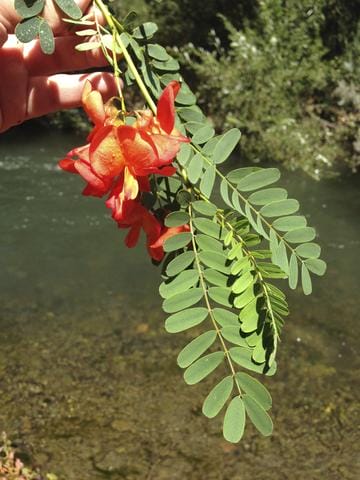
Scarlet Wisteria Threats for People and Wildlife:
- Heavy water user
- Shallow root systems increase erosion
- Creates dense thickets
- Displaces native vegetation
- Toxic and potential lethal to humans and wildlife if ingested
Scarlet Wisteria Life cycle & Habitat:
Flowers and seedpods are produced in late spring and persist through fall between June and September. A single plant can produce between 100-1000 pods annually. Seed germination rate is high and the seed bank can last for many years. Scarlet Wisteria favors warm moist environments and is most problematic when growing along the banks of rivers, streams, creeks, wetlands and marshes. It forms dense thickets and quickly colonizes entire riverbank systems.
Scarlet Wisteria: How you can help Russian Riverkeeper eradicate it!
- Call us if you see it – even if unsure – please contact us with location and whether it has seeds.
- Provide access to Dry Creek for eradication workdays, looking for boat launch or plant waste haul-out locations or where we can access plants on foot. We can provide insurance coverage.
- Volunteer for Wisteria Eradication workdays-TBA June to September – experience boaters for water work and people to help haul out plant material as it is removed.
- Donate to Riverkeeper’s Scarlet Wisteria Eradication Project – mark your donation SWEP to support our costs and ensure we win the battle against this thirsty invader!
If you see Red Wisteria please call us at 707-433-1958 or e-mail info@russianriverkeeper.org with the location, number of plants and if it’s seeded yet.
Scarlet Wisteria Resources:
http://www.blm.gov/ca/st/en/fo/redding/weeds/rattlebox.html
http://www.cal-ipc.org/ip/management/plant_profiles/Sesbania_punicea.php
http://www.calflora.org/cgi-bin/species_query.cgi?where-calrecnum=8578
